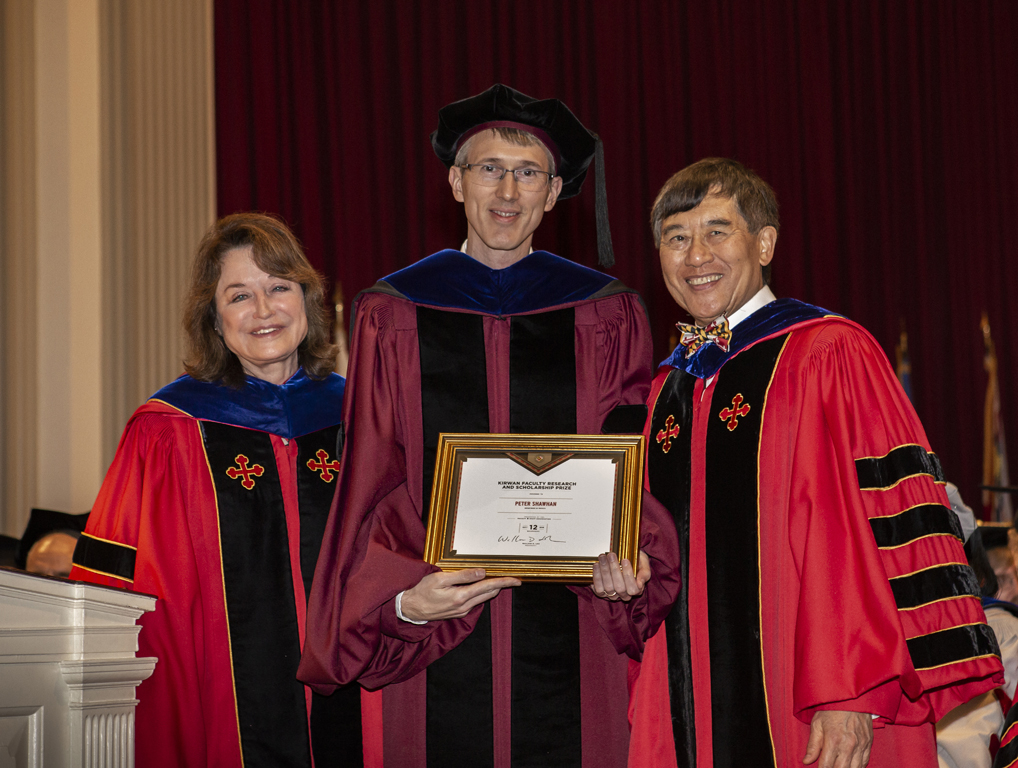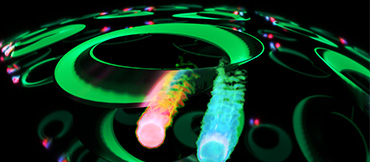Modified Superconductor Synapse Reveals Exotic Electron Behavior
- Details
- Category: Research News
- Published: Wednesday, September 19 2018 10:28
 JQI researchers modified a Josephson junction to include a sliver of topological crystalline insulator (TCI). Using this circuit, they detected signs of exotic quantum states lurking on the TCI's surface. (Credit: E. Edwards/JQI)
JQI researchers modified a Josephson junction to include a sliver of topological crystalline insulator (TCI). Using this circuit, they detected signs of exotic quantum states lurking on the TCI's surface. (Credit: E. Edwards/JQI)
Electrons tend to avoid one another as they go about their business carrying current. But certain devices, cooled to near zero temperature, can coax these loner particles out of their shells. In extreme cases, electrons will interact in unusual ways, causing strange quantum entities to emerge.
At the Joint Quantum Institute (JQI), a group, led by Jimmy Williams, is working to develop new circuitry that could host such exotic states. “In our lab, we want to combine materials in just the right way so that suddenly, the electrons don’t really act like electrons at all,” says Williams, a JQI Fellow and an assistant professor in the University of Maryland Department of Physics. “Instead the surface electrons move together to reveal interesting quantum states that collectively can behave like new particles.”
These states have a feature that may make them useful in future quantum computers: They appear to be inherently protected from the destructive but unavoidable imperfections found in fabricated circuits. As described recently in Physical Review Letters, Williams and his team have reconfigured one workhorse superconductor circuit—a Josephson junction—to include a material suspected of hosting quantum states with boosted immunity.
Josephson junctions are electrical synapses comprised of two superconductors separated by a thin strip of a second material. The electron movement across the strip, which is usually made from an insulator, is sensitive to the underlying material characteristics as well as the surroundings. Scientists can use this sensitivity to detect faint signals, such as tiny magnetic fields. In this new study, the researchers replaced the insulator with a sliver of topological crystalline insulator (TCI) and detected signs of exotic quantum states lurking on the circuit’s surface.
Physics graduate student Rodney Snyder, lead author on the new study, says this area of research is full of unanswered questions, down to the actual process for integrating these materials into circuits. In the case of this new device, the research team found that beyond the normal level of sophisticated material science, they needed a bit of luck.
“I'd make like 16 to 25 circuits at a time. Then, we checked a bunch of those and they would all fail, meaning they wouldn’t even act like a basic Josephson junction,” says Snyder. “We eventually found that the way to make them work was to heat the sample during the fabrication process. And we only discovered this critical heating step because one batch was accidentally heated on a fluke, basically when the system was broken.”
Once they overcame the technical challenges, the team went hunting for the strange quantum states. They examined the current through the TCI region and saw dramatic differences when compared to an ordinary insulator. In conventional junctions, the electrons are like cars haphazardly trying to cross a single lane bridge. The TCI appeared to organize the transit by opening up directional traffic lanes between the two locations.
The experiments also indicated that the lanes were helical, meaning that the electron’s quantum spin, which can be oriented either up or down, sets its travel direction. So in the TCI strip, up and down spins move in opposite directions. This is analogous to a bridge that restricts traffic according to vehicle colors—blue cars drive east and red cars head west. These kinds of lanes, when present, are indicative of exotic electron behaviors.
Just as the careful design of a bridge ensures safe passage, the TCI structure played a crucial role in electron transit. Here, the material’s symmetry, a property that is determined by the underlying atom arrangement, guaranteed that the two-way traffic lanes stayed open. “The symmetry acts like a bodyguard for the surface states, meaning that the crystal can have imperfections and still the quantum states survive, as long as the overall symmetry doesn’t change,” says Williams.
Physicists at JQI and elsewhere have previously proposed that built-in bodyguards could shield delicate quantum information. According to Williams, implementing such protections would be a significant step forward for quantum circuits, which are susceptible to failure due to environmental interference.
In recent years, physicists have uncovered many promising materials with protected travel lanes, and researchers have begun to implement some of the theoretical proposals. TCIs are an appealing option because, unlike more conventional topological insulators where the travel lanes are often given by nature, these materials allow for some lane customization. Currently, Williams is working with materials scientists at the Army Research Laboratory to tailor the travel lanes during the manufacturing process. This may enable researchers to position and manipulate the quantum states, a step that would be necessary for building a quantum computer based on topological materials.
In addition to quantum computing, Williams is driven by the exploration of basic physics questions. “We really don't know yet what kind of quantum matter you get from collections of these more exotic states,” Williams says. “And I think, quantum computation aside, there is a lot of interesting physics happening when you are dealing with these oddball states.”
Written by E. Edwards and S. Elbeshbishi

